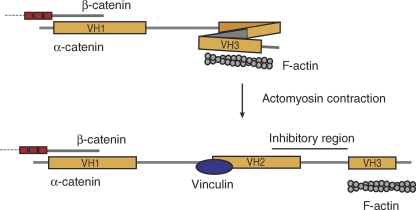Figure 3.
A model for tension-induced conformational changes in αE-catenin. αE-catenin may act as a mechanosensor to transduce changes in force to changes in the strength of cell–cell adhesions by recruiting additional adaptor proteins. See the text for further discussion. When αE-catenin is not under tension, its conformation may allow an inhibitory region to block its vinculin binding site. Upon the application of force, such as actomyosin-mediated contraction transduced through is C-terminal F-actin binding domain, αE-catenin may undergo a conformational change that displaces the inhibitory region from the vinculin binding site, allowing vinculin to bind. Vinculin, which has its own F-actin binding site, may in turn recruit additional F-actin to the CCC (Yonemura et al., 2010).

